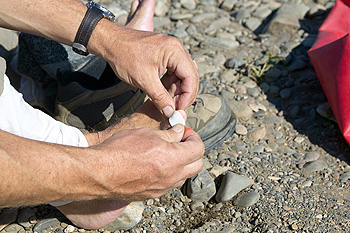How to Prevent Blisters When Hiking
Monday, 18 February 2019 00:00 Blisters are very common, and despite being small they can be very aggravating. Blisters are even more common for people who regularly participate in physical activities. Hiking is an example of a pastime that can easily result in uncomfortable blisters, especially hiking in boots. Thankfully, there are some ways to help prevent blisters from forming. Wearing shoes that fit properly is probably the most important aspect of preventing blisters. Shoes that have been broken in are optimal because they will form around your foot naturally. Always wear socks, but preferably not cotton socks because cotton holds moisture close to the skin. Moisture helps blisters thrive, so it is best to keep your feet dry. Supportive insoles are also useful because they help keep your foot in place and prevent it from sliding around in your shoe. If you have a blister or would like more information on how to prevent blisters, speak with a podiatrist.
Blisters are very common, and despite being small they can be very aggravating. Blisters are even more common for people who regularly participate in physical activities. Hiking is an example of a pastime that can easily result in uncomfortable blisters, especially hiking in boots. Thankfully, there are some ways to help prevent blisters from forming. Wearing shoes that fit properly is probably the most important aspect of preventing blisters. Shoes that have been broken in are optimal because they will form around your foot naturally. Always wear socks, but preferably not cotton socks because cotton holds moisture close to the skin. Moisture helps blisters thrive, so it is best to keep your feet dry. Supportive insoles are also useful because they help keep your foot in place and prevent it from sliding around in your shoe. If you have a blister or would like more information on how to prevent blisters, speak with a podiatrist.
Blisters are prone to making everyday activities extremely uncomfortable. If your feet are hurting, contact Dr. Steven Schwartz of Pennsylvania. Our doctor can provide the care you need to keep you pain-free and on your feet.
Foot Blisters
Foot blisters develop as a result of constantly wearing tight or ill-fitting footwear. This happens due to the constant rubbing from the shoe, which can often lead to pain.
What Are Foot Blisters?
A foot blister is a small fluid-filled pocket that forms on the upper-most layer of the skin. Blisters are filled with clear fluid and can lead to blood drainage or pus if the area becomes infected.
How Do Blisters Form?
Blisters on the feet are often the result of constant friction of skin and material, usually by shoe rubbing. Walking in sandals, boots, or shoes that don’t fit properly for long periods of time can result in a blister. Having consistent foot moisture and humidity can easily lead to blister formation.
Prevention & Treatment
It is important to properly care for the affected area in order to prevent infection and ease the pain. Do not lance the blister and use a Band-Aid to provide pain relief. Also, be sure to keep your feet dry and wear proper fitting shoes. If you see blood or pus in a blister, seek assistance from a podiatrist.
If you have any questions, please feel free to contact our offices located in Chambersburg, and Mcconnellsburg, PA . We offer the newest diagnostic and treatment technologies for all your foot care needs.

